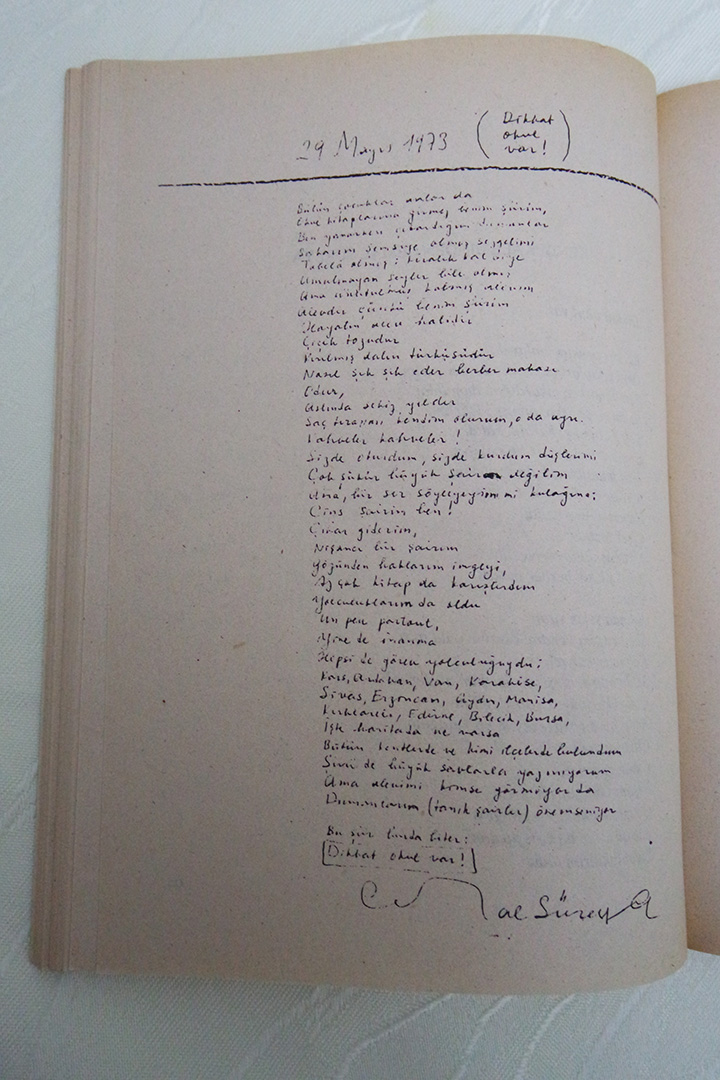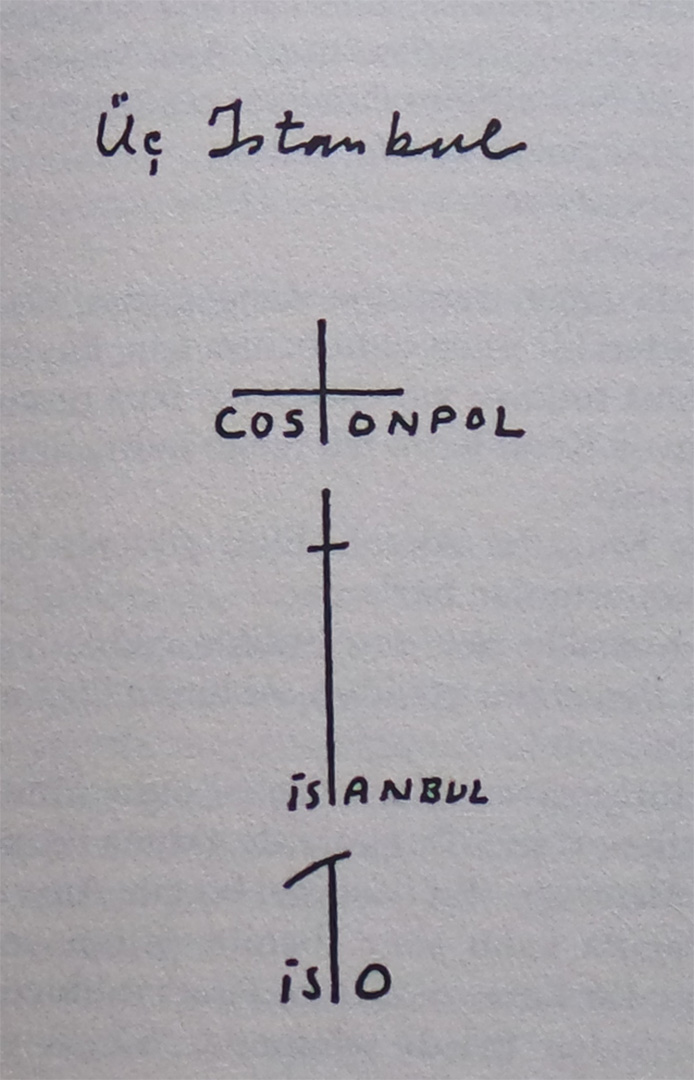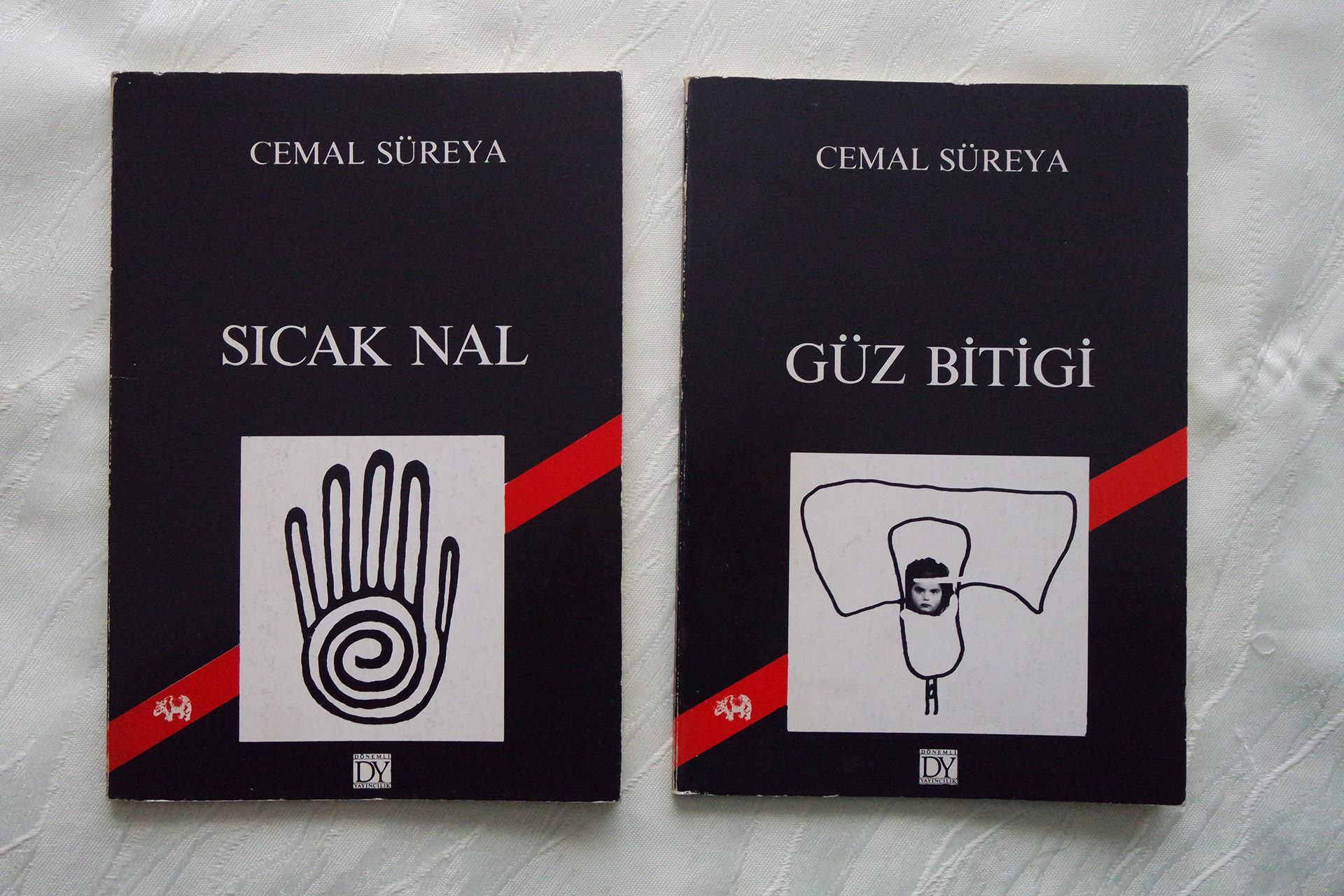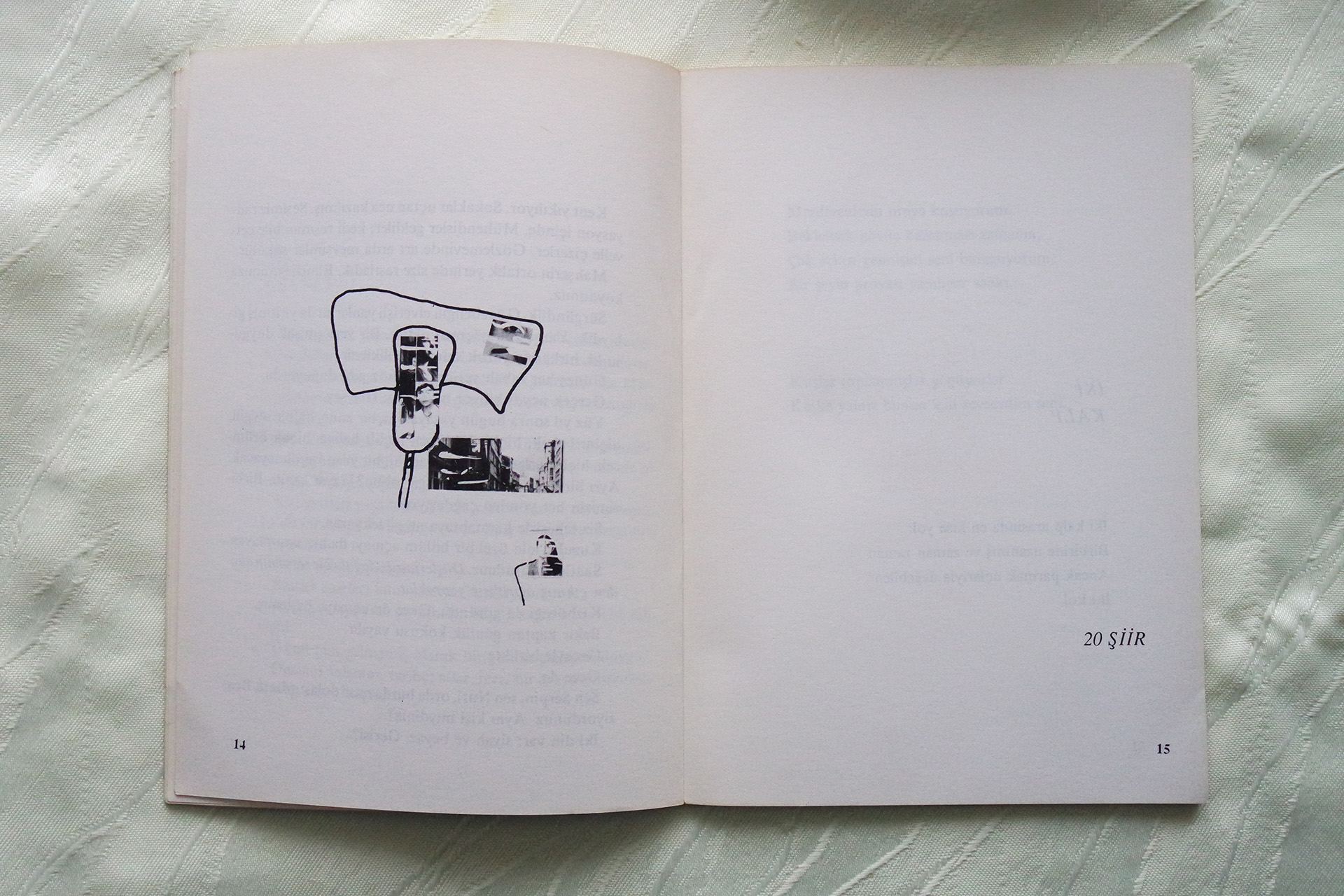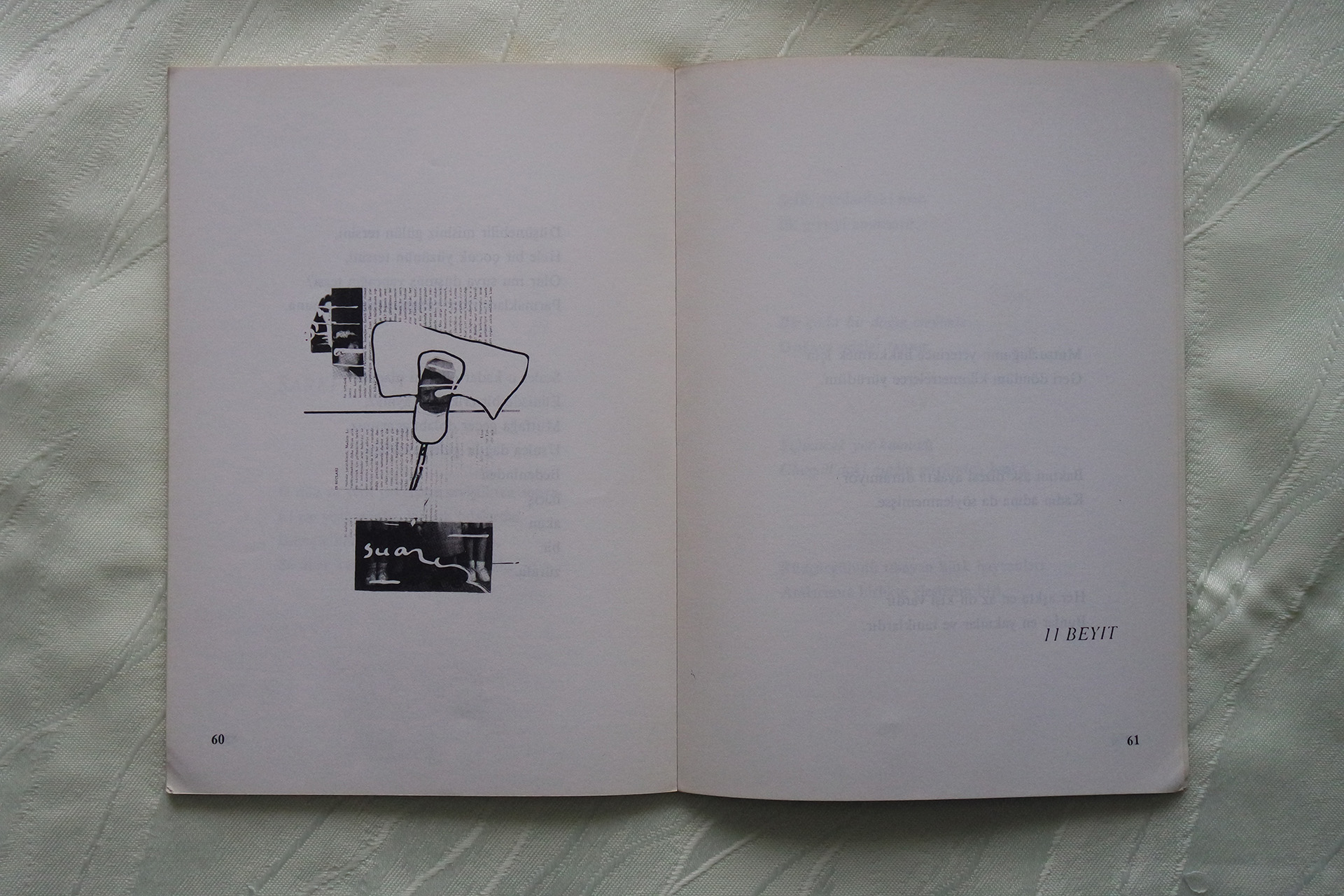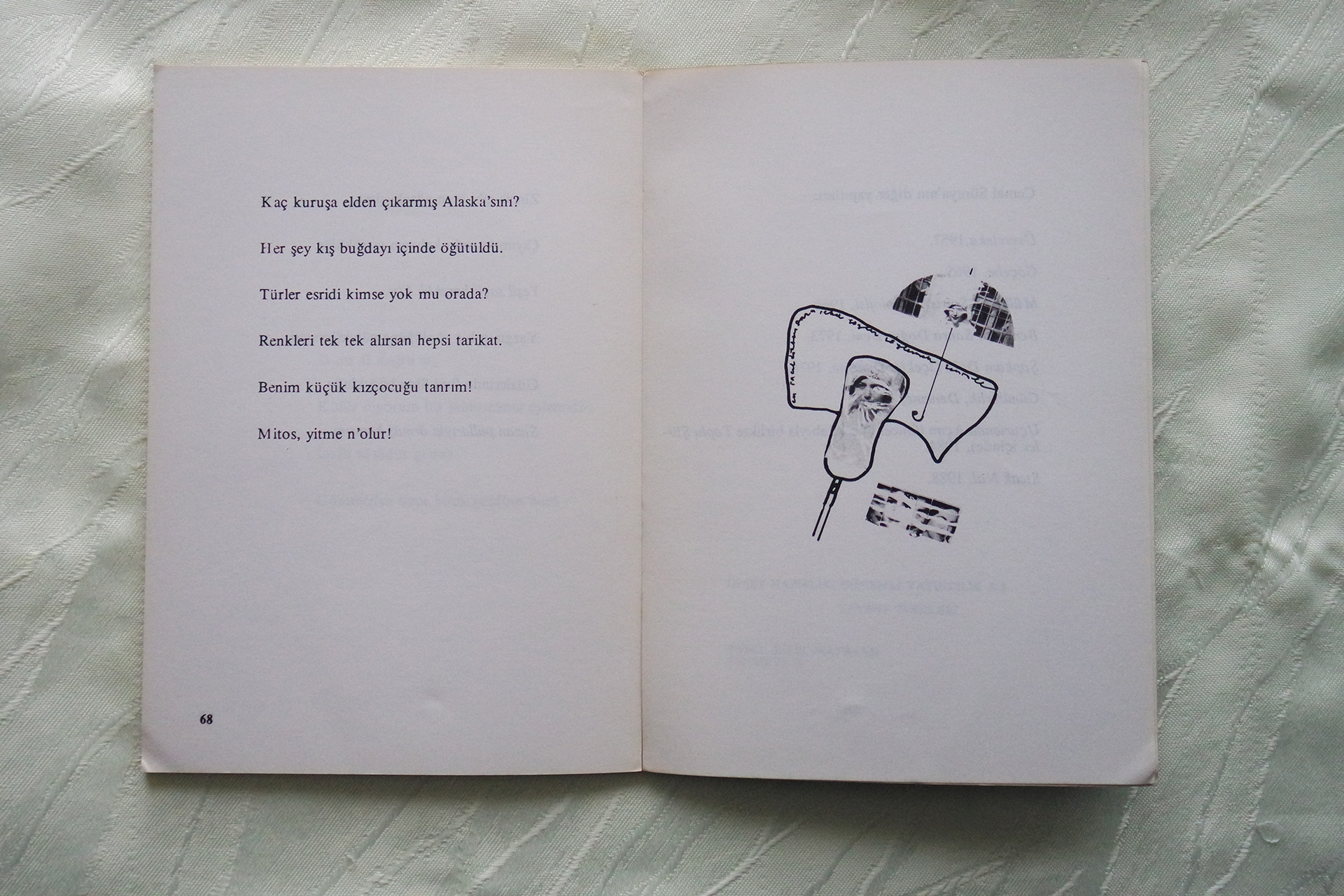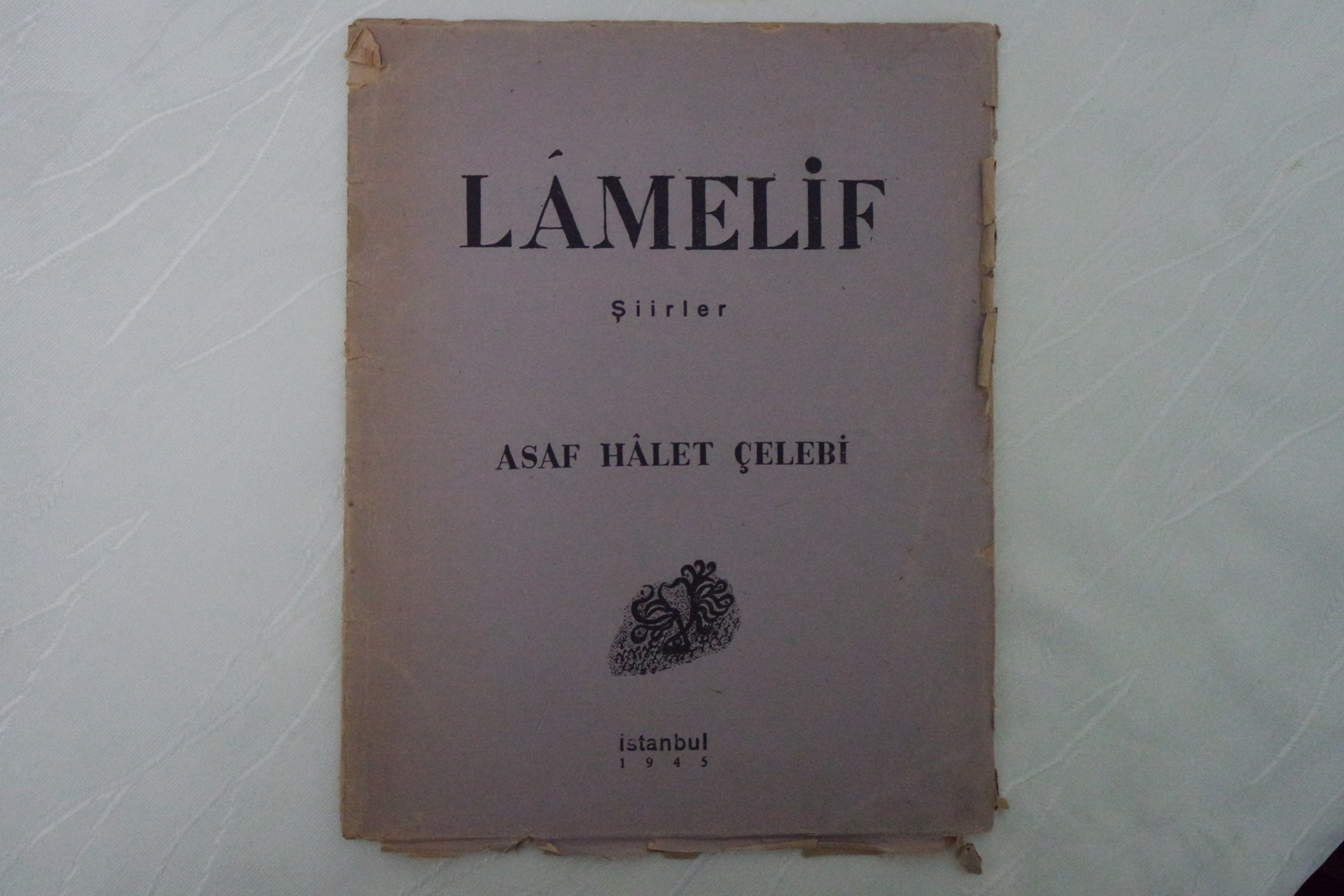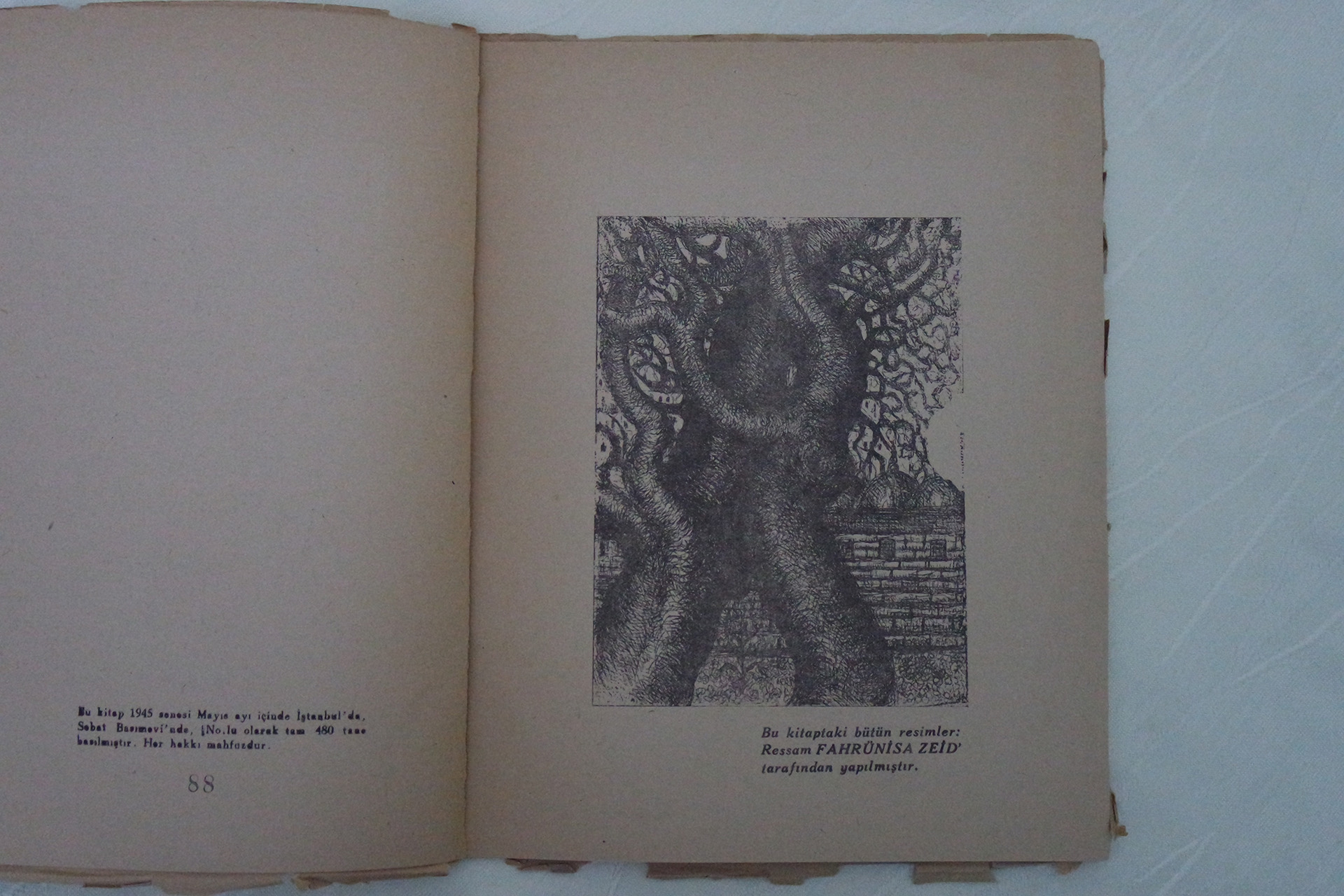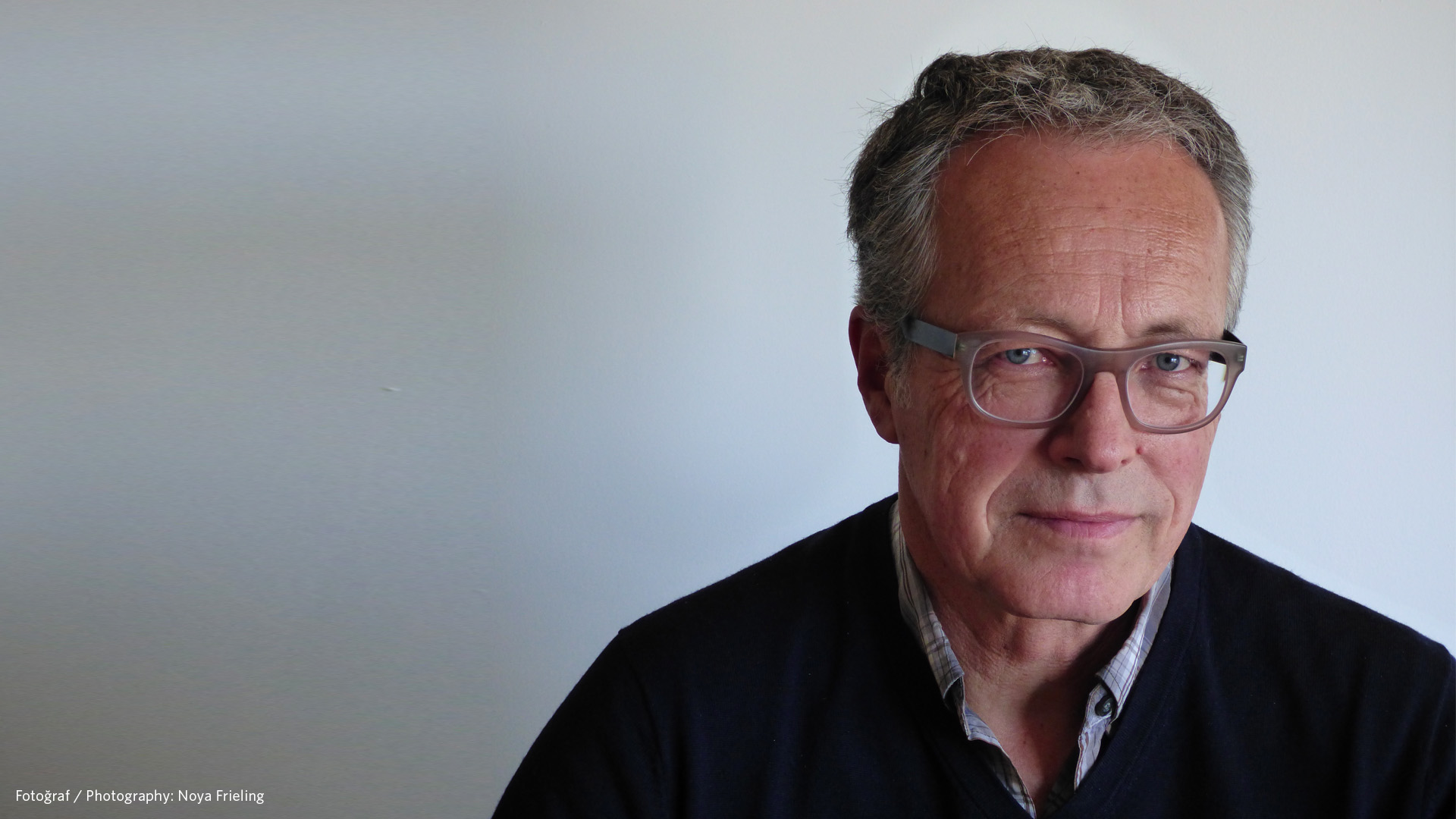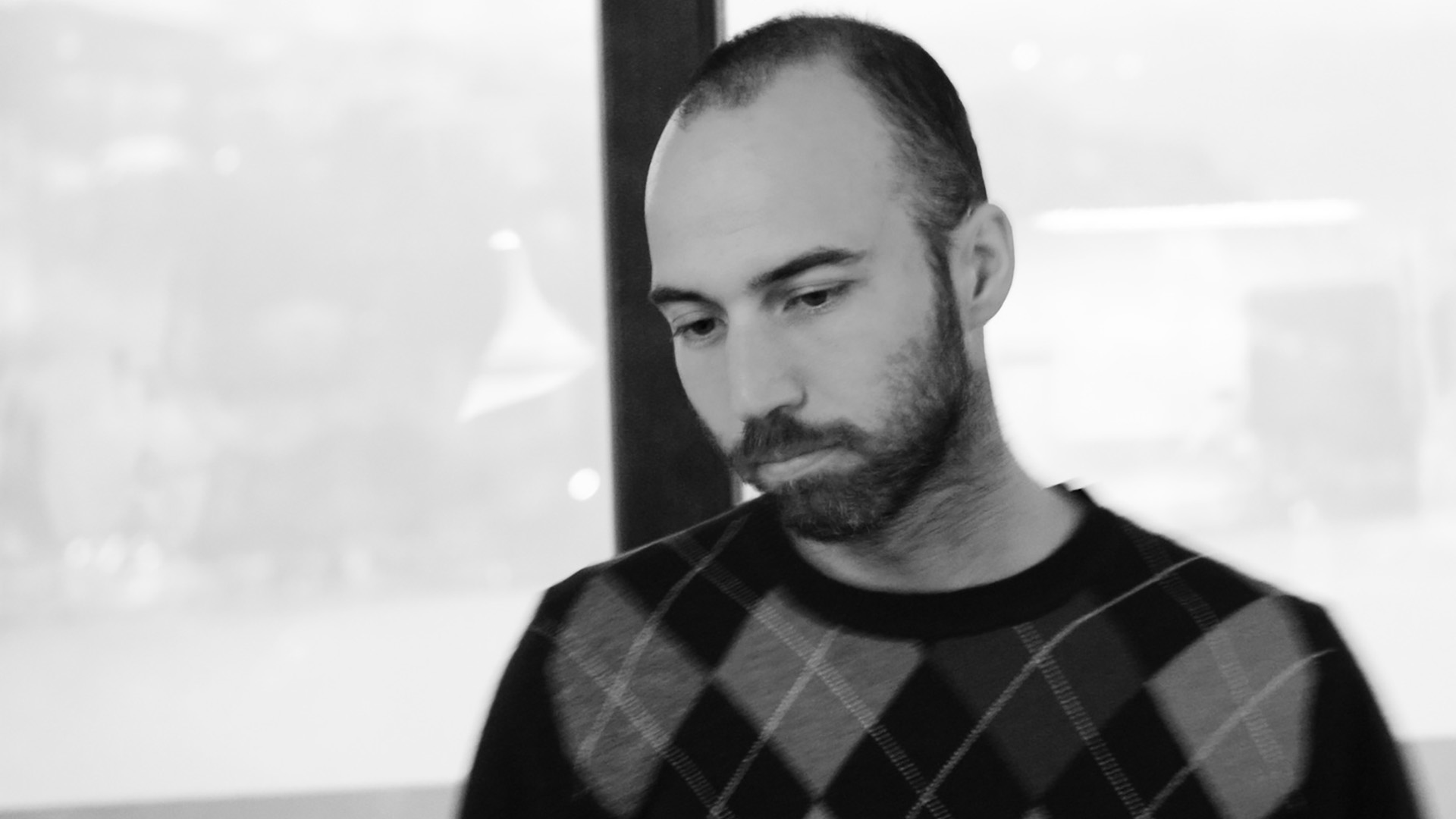Blog
“YOU KNOW WHAT IS IN YOUR VOICE
A SLEEPLESS TURKISH”
14 December 2018 Fri
A conversation on Cemal Süreya’s poetry and his multi-dimensional creativity.
Necmi Sönmez
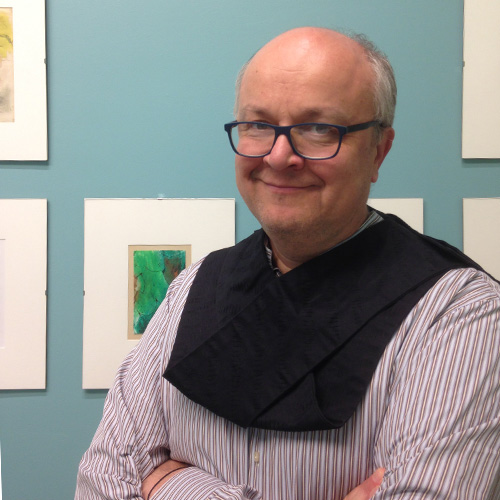
NECMİ SÖNMEZ
buero@necmisoenmez.de
Fotoğraf: Yeşim Demir
On November 10, 2018, we organized a conversation around the exhibition I curated at Borusan Contemporary, “Üvercinka”, together with poet Turgay Fişekçi and editor, translator Selahattin Özpalabıyıklar. My guests were close friends of Cemal Süreya, who had witnessed the different phases of his production. They were familiar with his processes having edited and published his works.
I was contributing to the magazine 2000’e Doğru between 1987 and 1989; as a novice, I met Cemal Süreya and I was struck by his charisma. At the magazine’s offices, Şule Perinçek introduced us and when Süreya said that he had read my writing, I was even more embarassed. I was talking to Cemal Süreya after all and he was saying that he had read my writings. That was one of the happiest days of my life. We spoke about Zühtü Müridoğlu, Cemal Tollu a few times. I did not expect him to be such an avid follower of modern art. The way he talked was so sweet and so engaging that he was drawing in people like a magnet. His room resembled an actual train station, quickly filling with his friends and all that was left to me was to leave quietly. I started collecting first editions of his books and I’m still sad today that I didn’t think to have them be signed by the author before I left Istanbul. Cemal Süreya was an extraordinarily creative person. I dream of one day collecting his drawings, paintings, calligrams, and his signatures that resemble hieroglyphics in a book.
I had asked the participants to respond to some of my questions by writing, both before and after our talk. The anxiety and excitement of a talk usually lead to repetitions and mistakes. To overcome this problem, I thought it would be better to document the written answers and our conversation.
This is the first time that I organized an event around creative literature and the participation of Nursel Duruel, Turgut Çeviker who had also been witnesses of Cemal Süreya’s journey in poetry was very exciting to me. I feel the same excitement as I write out these lines.
Necmi Sönmez: What would be the context in which we can think about Üvercinka (1958) within the narrative of the historic development of Modern Turkish Poetry? It would perhaps make sense to define the position that Süreya took at the time.
Turgay Fişekçi: Although Üvercinka was published in 1958, the included poems are from 1953 to 1957. When Cemal Süreya started to write the poems that would rejuvenate contemporary Turkish poetry in 1953, he was 22 years old. We do not see the novice styles that we could observe in Turgut Uyar’s Arz-ı Hal (1949) and Edip Cansever’s İkindi Üstü (1947). Süreya began writing mature poems, without a trace of the styles we associate with being young. In particular, his poems, “Sizin Hiç Babanız Öldü mü?”, ”Adam”; 1954’te yazılmış “Gül”, “Önceleyin”, “Güzelleme”, “Aşk” and “Cıgarayı Attım Denize” from 1953 are not only important examples of Süreya’s works but are also the first poems of the sensibility of the İkinci Yeni.
It is always a point of contention as to how the İkinci Yeni started and by whom. Edip Cansever’s “Masa da Masaymış Ha” is dated 1954, his “Yerçekimli Karanfil” is dated 1957. Oktay Rifat’s book Perçemli Sokak is dated 1956; İlhan Berk’s “Saint-Antoine’ın Güvercinleri”, which he claims to have been the first poem of the İkinci Yeni, are also dated 1956. Critic Muzaffer Erdost coined this movement as the “İkinci Yeni” in an article he wrote for Pazar Postası in 1956 also. When we look at these dates, it is possible to say that Cemal Süreya wrote the first poems of the İkinci Yeni.
It is of course important to look at what happened before. The first rupture of contemporary poetry was at the end of the 1920s, beginning of the 1930s with Nâzım Hikmet. The Garip movement in the 1940s was the second move to rejuvenate our poetry.
When Orhan Veli died in 1950, the Garip movement had ended. It was inevitable that the 1950s would lead to new searches, new ruptures. In the 1940s, there were important poets who were outside of the Garip movement including Fazıl Hüsnü Dağlarca, Behçet Necatigil, Cahit Külebi, but it is critical to point to Attilâ İlhan as the poet who paved the road for the İkinci Yeni. Because Attilâ İlhan is the first poet whose work showed traces of the French Surrealist poems, which was also a source of inspiration for Cemal Süreya as well. The poems included in Sisler Bulvarı (1954) were published in the first years of the 1950s.
Cemal Süreya retained the simplicity of the Garip poems on the one hand, while enriching this simplicity, pushing the boundaries of language under the influence of the French Surrealist poets that he was reading. He’d say, “If you pull a hair from Turkish, there are suns, worlds, rivers embedded within it.” He went after those suns, the worlds and rivers. In our poetry, he began with Yahya Kemal and pursued the love of Turkish through the works of Nâzım Hikmet and Orhan Veli.
He was never interested in “common” ways of articulation. With a striking order of images, he was able to write about the associations of his imagination using a simple narrative.
His close relationship with the quotidian language draws him close to Orhan Veli, while his unique inventiveness, intelligence and irony that he uses to find new words and comparisons connect him to Apollinaire and Eluard.
His attitude showed that a type of poetry that was deemed “closed” could be opened up infinitely.
Selahattin Özpalabıyıklar: Turgay has addressed the emergence of the İkinci Yeni and the role that Cemal Süreya played within the İkinci Yeni quite well, so there is not much left for me to say about that. I could talk about the predecessors of the movement İkinci Yeni. And as Turgay has mentioned, one such candidate is İlhan Berk and another is Oktay Rifat.
İlhan Berk started the movement with the poem “Saint Antoine’ın Güvercinleri” as Turgay has mentioned.
Oktay Rifat claims: “Perçemli Sokak came out in 1956. The poems included in the book had not been published in magazines before. But they were not written overnight in 1956, obviously. It must have taken over a year to write them. The İkinci Yeni was established with Perçemli Sokak. However, those who wanted to establish this movement wanted to trace the origins back further and they wanted to leave me out of it.”
Cemal Süreya refutes Oktay Rifat’s claim in a conversation that Tomris Uyar had organized, asking questions to Edip Cansever, Cemal Süreya, and Turgut Uyar, titled, “A Conversation on Age and Poetry”: “Oktay Rigat claims that he established the İkinci Yeni. Our poems were also written in the early 1950s, but we were not able to publish our books. Oktay Rifat published Perçemli Sokak in 1956, none of the poems included in the book were published before. And he attempted to assume ownership of the movement in a prologue. Özdemir İnce paid attention to this one detail. In a text I wrote, I said ‘A year ago’ and Özdemir calculated that it was only three months ago. In a talk he gave after having received the Yeditepe Poetry Award, Oktay Rifat responds to the question of “What is Poetry?” with this answer: ‘Poetry is to find a cure for the social problems of the people.’ Özdemir suggests that he founded the İkinci Yeni movement three months after that. Let’s attribute this to Oktay Rifat’s mistake in figuring out the calendar. He wrote those poems in relation to the poems that we published in magazines. And they are mechanic poems, they are not quite settled.”
Necmi Sönmez: Is it possible to draw an organic relationship between Üvercinka and the İkinci Yeni?
Turgay Fişekçi: I think we must first question whether there is an organic bond within the İkinci Yeni. Because Cemal Süreya, in a statement, said "We did not know each other, how could we be part of a movement.” If we look at the year 1956 when the name of the İkinci Yeni was officialized, we can see that there was a fierce argument among the poets in terms of who was to take the leadership of the İkinci Yeni. But if you ask me, Cemal Süreya, who was never been in this race, wrote the first poems of this movement. On the other hand, his book, Üvercinka, has been one of the cult books of this movement since 1958 to our present day.
Selahattin Özpalabıyıklar: In one of his last interviews, Cemal Süreya answered Enver Ercan's question, “What is your relationship with the İkinci Yeni?” with a joking attitude, referring to Nursel Duruel’s The A to Z of Cemal Süreya; he was making the widest description of the movement including the different connections it included.
“I’m the İkinci Yeni. If we don’t count Ece, Turgut, Sezai, Edip, Can, Tevfik, Özdemir, Nihat, Gülten, Hilmi, Ergin, Metin, Dağlarca, Ahmet, Ahmed Arif, Arif Damar, Oktay Rifat, Melih Cevdet, Behçet Necatigil, Mehmet Kemal, Şeyh Galib, Nâzım. There is also Yılmaz, Attilâ, İsmet Özel, Behram, Berfe!..
I think this listing is the best summary of how the İkinci Yeni transformed our contemporary poetry and is also expression of the continuousness of our tradition of poetry; it is an expression of these aspects in the Cemal Süreya style.
Necmi Sönmez: We prepared the exhibition Üvercinka on the 60th anniversary of its publishing, aiming to present an interdisciplinary perspective. Süreya had a close relationship with many aspects of the visual arts, in particular with painting. We know that he made drawings and he included paintings in his letters. We brought together some of these works from private archives. Do you think it’s possible to talk about a dialogue between Süreya’s poetry and modern painting? We know from his diaries that he was particularly interested in many artists, in particular artists working in the abstract such as Klee and Giacometti. Could you tell me what you think about this connection?
Turgay Fişekçi: Edip Cansever visited Ahmet Hamdi Tanpınar one day during his first years writing poetry. In front of the young poet opposite him, Tanpınar put on paintings of modern painters such as Paul Klee and Kandinsky and said that he needed to know about these paintings in order to become a poet.
We know that the İkinci Yeni Poets, especially Cemal Süreya, were influenced by the French Surrealists. Perhaps the most important feature of the French Surrealist poets is that they lived together with and worked alongside painters, filmmakers and so on. Therefore, it is impossible to say that Cemal Süreya was not affected by the relationship they established between painting and poetry. I have a direct testimony on this subject: In 1983, when Üç Çiçek Yayınevi wanted to make Üvercinka's new edition, Cemal Süreya wanted to have a Picasso painting on the cover. The effect of this generation on Cemal Süreya is so obvious that when you put the handwriting poems of Cemal Süreya and Apollinaire side by side, you will see a clear similarity. Cemal Süreya’s signature is very similar to Saint Exupery's Little Prince drawing of the elephant swallowing the boa snake. Cemal Süreya was very interested in this generation of French poets and painters that he knew, for example, the collar number of Apollinaire in his military uniform in World War I.
Selahattin Özpalabıyıklar: Let me make an addition to what Turgay says: Cemal Süreya feels such a camaraderie towards Apollinaire that he refers to him as “Apo” as if he were a close friend. On the other hand, in the poem “Aslan Heykelleri”, the lines “Ya bu başını alıp gidiş boynundaki / Modigliani oğlu modigliani”, he is referring to Modigliani, who is known for the extended lengths of the figures’ necks in their paintings. You have already stated that Cemal Süreya himself is good with drawing. As Turgay says, even his signature is a picture. In one of his journals, on 1989, day 975, he writes, “How do we start to despise Istanbul? To get away from here, to go somewhere in the south. For my part, can I do that? Am I not a part of Istanbul anymore? Is being without Istanbul the biggest danger of all? At the moment, nothing is more appropriate than including my ‘semiologic’ Istanbul poem here, which was published in the first issue of Kitaplar, and which was not included in the book, although I had saved it for Sıcak Nal.
This poem is a “drawing” poem, it is a “painting-poetry”.
Güz Bitigi is also an interesting book in this sense. There are “1 prose, 20 poems, 1 song, 12 couplets, 16 lines, 5 performances” included in the book. What the poet calls “performance” are illustrations that he created by combining his own drawings and photographs of newspaper and magazine clippings, which resembled photo-montages.
Necmi Sönmez: Contemporary art, as seen in the Borusan Contemporary Art Collection, seeks to establish an atmosphere that embraces the viewer by using notions based on moving images such as the media of video and film. The poem has a seductive characteristic of attracting readers to a separate world through feelings and feelings based on images. Do you think bringing together contemporary art and poetry could help form a new path of looking?
Turgay Fişekçi: We could say that all the arts are intertwined. There is a relationship and interaction between the arts since the early ages. In the world of contemporary poetry, this interaction is at its maximum with Memleketimden İnsan Manzaraları. Although this major work by Nâzım Hikmet has an epic scope, it includes many genres within it including the novel, story-telling, reportage, screen writing, theater, history… From different perspectives, Memleketimden İnsan Manzaraları can be interpreted in different ways.
Contemporary art does not set limits on the language of expression; an area where the creator can act freely. Of course, it is expected to interact with poetry. But I don't know to what extent contemporary artists are interested in poetry. In the works I have followed, I observe that artists tend to be more inward-looking, directing themselves more to the creative process.
Selahattin Özpalabıyıklar: As far as I can see, poetry still maintains its connection with other arts (perhaps inevitably because its main material is language), but artists from other fields are becoming more introverted as Turgay says. The relationship to be established with poetry can be said to depend on the pleasure of poetry of the artists, and most of the time, depending on their personal friendship with poets.
Necmi Sönmez: We see that modern painters and poets have a close relationship in our country until the 1960s. In the 1940s, the collaboration of Nâzım Hikmet with Fikret Mualla and Abidin Dino and Asaf Hâlet Çelebi with Fahrelnissa Zeid continued in the 1950s with Edip Cansever's collaborations with Orhan Peker and İlhan Berk with Turan Erol. But after the 1960s, we see the breakdown of this dialogue. What do you think about these collaborative works that are highly inspirational for both fields?
Turgay Fişekçi: I personally believe that not only painting and poetry but all arts are in touch with each other. I believe that this process is seen as a “person of culture” by the older generations, and after the 1960s, this feature has first turned into a political militancy and after the 1980s, became “self-love.” Everyone began to love themselves so much that they do not have a place to love others in the world. For this reason, the painter lives in their own studio, in the poet in their room, the musician lives with their instrument, and the stage actor lives happily on their own stage.
In recent years, as an exception in the art world, we can remember the compositions made by Fazıl Say featuring works by Turkish poets.
Selahattin Özpalabıyıklar: The name of a book that included selections from Burhan Uygur’s painting notebooks, “Bir Kitapta Resim Şart” [You Need Paintings in a Book], is the last line of a poem by Cemal Süreya and just like many other poems by him, it has become a slogan. “Kılıç kalkan gürz ve at / Tâ çocukluğumdan beri / Ne buldumsa okudum / Sonunda anladım ki / Bir kitapta resim şart.”
There are many examples in the 1950s, including Lamelif, which is a collaboration between Asaf Hâlet Çelebi and Fahrelnissa Zeid. Many of Metin Eloğlu’s books included his own drawings or drawings by Orhan Peker or Ara Güler’s photographs; the books of poetry published by Yeditepe Publishing were illustrated by Agop Arad—these are just a few examples of the friendship between poetry and painting. In Behçet Necatigil’s book Evler, which was published by Yeditepe, Arad drawings were featured, an atypical example. Further back, Orhon Murat Arıburnu had opened a painting-poetry exhibition in 1947, a first in Turkey.
I agree with Turgay in terms of today's disconnectedness. Also, it should not be forgotten that “word artists” such as poets and writers and plastic artists such as painters, sculptors, lived together in artistic communes almost. This closeness has now disappeared. There is no more “mahfil”s [gathering place] where the literary artist and the visual artist came together.
Necmi Sönmez: The period after 1945, when Abstract Art was brought to the agenda in Modern Turkish Art, coincides with the time when new searches started to flourish in Modern Turkish Poetry. Do you think it is possible to establish a connection between Abstract Art and the İkinci Yeni movement?
Turgay Fişekçi: Certainly possible. The İkinci Yeni I think is the last research movement in our poetry. This generation was interested not only in abstract art, but also in anything that could help their poetry. Edip Cansever, for example, discovered T.S. Eliot. Although he doesn't speak English, he reads this poem to a friend who knows the language; he was trying to figure out what he said and how he said it. Edip Cansever is one of the first poets to discover Seferis, an important name in the contemporary world poetry. Ece Ayhan, found resources for his poems from Ottoman Turkish texts. In Turgut Uyar’s work, the heavy air of the sacred texts can be perceived. It should not be forgotten that the years when this generation started to write were also the brightest years of the Academy of Fine Arts.
Selahattin Özpalabıyıklar: Muzaffer Erdost coined the name of the movement; he was the first one to mention the relationship of the İkinci Yeni with abstract art. He argued that the İkinci Yeni, like abstract paintings or tiles and kilim embroideries, was not saying anything, was thus “meaningless”. Hüseyin Cöntürk, one of the important critics of the period, on the other hand, said the opposite: in order to understand the purpose of the İkinci Yeni in relation to meaning (based on the words of Hilmi Yavuz), atonal music, which is also called concrete music, should be taken as the roots. In my opinion, what is important is not arguing over who was right, but rather thinking about how both situations require abstraction to be “understood.” Both abstract and concrete arts and poetry essentially rely on abstraction, no?
Necmi Sönmez: I want to thank you for both your talk and your written answers.
ABOUT THE WRITER
Necmi Sönmez
Received his education on art history at Mainz, Paris, Newcastle and Frankfurt Universities. He received his PhD at Johann Wolfgang Goethe University on sculpture Wolfgang Laib. Recently he is working as independent curator in Düsseldorf for different institutions among them Tate, Staatliche Museen Berlin, Borusan Contemporary, Kiasma, Kunsthale Deutsche Bank, Sabancı Museum. Since 2015 he is collaborating with SKIRA editore, Milan, as an independent editor.
ABOUT THE INTERVIEWEES
Selahattin Özpalabıyıklar
Born in Çubuklu in 1955, he is an editor, a translator, and a writer. He worked at a newspaper as a correspondent, proofreader, and puzzle creator; he worked at two encyclopedias as a writer, translator, and proofreader; he worked at three publishing houses as a copyreader, editor, and chief editor. He prepared a city monography with a selection of poems, stories, and essays; he organizes two editing workshops. He has translated numerous books. His own book, Göndermeler: Yazı, yanıt, söyleşi, anı came out in October 2018.
Turgay Fişekçi
Born in 1956 in Balıkesir, he completed his studies at the Istanbul University Law School. He started working in the field of publishing and writing as a student. When he finished his studies, he took on publishing as his work. His first book of poetry, Karda Işıltılar won the 1980 Academy Publishing Poetry Prize. His later books of poetry, Kuşkuluyum Yaşadığımdan (1983), Yitik Bahar (1989), Dip Sevgi (1994, Behçet Aysan Poetry Prize), Sevgi Bağları (1998, Behçet Necatigil Poetry Prize, Halkevleri Poetry Prize), Güzelle Büyü (2013, Melih Cevdet Anday Poetry Prize), Nerdesin? (2017, Fazıl Hüsnü Dağlarca Poetry Prize).
